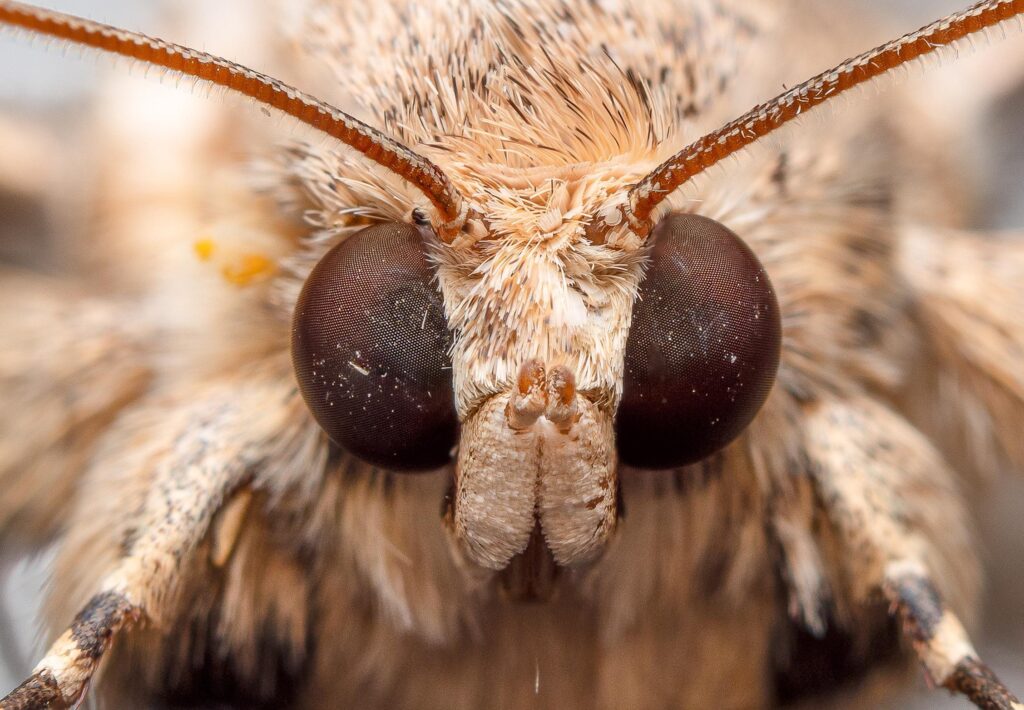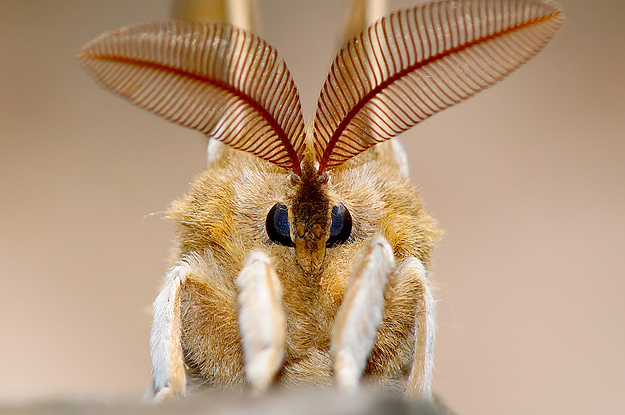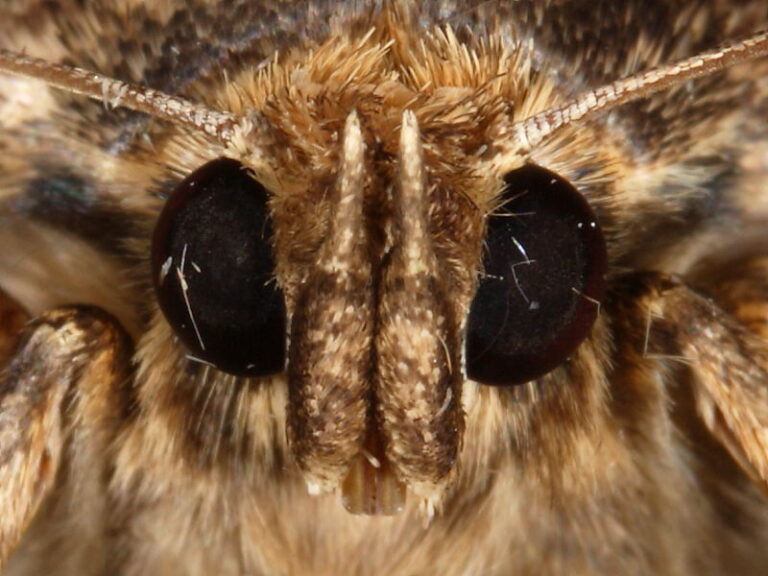No, moths do not have teeth. Moths are insects, and like many other insects, they do not possess teeth for chewing or biting. Instead, moths have a specialized mouthpart called a proboscis, which is a long, flexible tube-like structure that they use for feeding on liquids, such as nectar from flowers.
Moths primarily feed on nectar, sap, or other liquid sources, and their proboscis is adapted for sipping and sucking up these fluids. They do not have the jaw structure or teeth that mammals or some other animals have for chewing solid food. Moths are generally not known for consuming solid foods, as their diet primarily consists of liquids.
How is a moth’s body structured?
Moths are insects belonging to the order Lepidoptera, which also includes butterflies. They have a segmented body divided into three main parts: the head, thorax, and abdomen.
In addition, moths typically have two pairs of wings covered in scales, which give them their characteristic appearance.
They are known for their diverse and often intricately patterned wing designs, which play a crucial role in species identification and mate attraction.
Moth Mouthparts:
Moth mouthparts are specialized for feeding on liquids and are adapted to their ecological niche. The primary component of their mouthparts is the proboscis, a slender, flexible tube.
The proboscis consists of two elongated maxillae that are modified to form a single structure. It remains coiled under the head when not in use. Moths lack mandibles or teeth, which are common in animals used for chewing or biting.
What is the function of a moth’s proboscis?

The proboscis is a remarkable adaptation that allows moths to feed on nectar, fruit juices, and other liquid food sources. It acts like a straw, enabling moths to access the nectar deep within flowers or other liquid resources.
The proboscis is equipped with tiny grooves and channels that facilitate the capillary action, drawing liquid up into the moth’s digestive system. It remains coiled when not in use, protecting it from damage and conserving energy.
How Moths Use Their Mouthparts for Feeding?
Moths locate food sources primarily through their keen sense of smell and vision. They are attracted to the scent and color of flowers.
When a moth finds a suitable food source, it unfurls its proboscis and inserts it into the flower or liquid resource. Capillary action allows nectar or other liquids to flow up the proboscis and into the moth’s body.
Moths will often hover in front of a flower while feeding, and they can extract nectar without causing damage to the plant. The energy obtained from the sugary nectar serves as fuel for their activities, including mating and egg-laying.
What do moths primarily feed on?
Moths exhibit a wide range of dietary preferences depending on their species and life stage. Adult moths primarily feed on liquids, with their primary source of sustenance being nectar from flowers. Moths are crucial pollinators, as they transfer pollen from one flower to another while feeding.
In addition to nectar, some moths may consume other liquid substances such as tree sap or rotting fruit juices. Additionally, it’s important to note that adult moths generally do not consume solid foods, as they lack the necessary mouthparts for chewing.
Liquid Feeding and Nectar Consumption:
The specialization in liquid feeding is a key adaptation in moths, especially in their adult stage. Nectar is a rich source of sugars, which provides moths with the energy required for their activities, such as flying and reproduction.
As pollinators, moths play a vital role in ecosystems by facilitating the reproduction of many flowering plants. Their ability to access nectar deep within flowers using their proboscis is an efficient means of obtaining nutrition while reducing damage to the plants.
How do moth mouthparts differ from those of animals with teeth?
Unlike mammals and some other animals that possess teeth, moths lack any form of teeth or mandibles. The absence of teeth reflects their specialization in liquid feeding and their reliance on the proboscis for this purpose.
Moths have evolved to fill a unique ecological niche that does not require the mechanical breakdown of solid foods through chewing.
Moth Mouthparts with Animals That Have Teeth:
Animals with teeth, such as mammals, reptiles, and some birds, have evolved teeth adapted to their specific dietary needs.
Teeth can vary widely in shape and function, from sharp carnivorous teeth for tearing flesh to flat molars for grinding plant material.
The presence of teeth in these animals allows them to process a variety of solid foods, including plants, insects, and meat.
In contrast, moths have specialized mouthparts designed exclusively for liquid feeding and are not equipped for chewing or grinding.
How have moth mouthparts evolved for efficient feeding?
Moth mouthparts have undergone remarkable evolutionary adaptations over millions of years to cater specifically to their liquid-feeding habits.
The proboscis, a tubular structure, likely evolved from the fusion of the maxillae, which were originally separate appendages.
This elongated proboscis allows moths to reach deep into flowers, accessing nectar that might be otherwise unreachable.
The proboscis is often covered in microscopic, hair-like structures that aid in absorbing liquids by capillary action.
Evolution has refined this structure to optimize its function, making it a highly efficient tool for liquid feeding.
How These Adaptations Benefit Moths in Their Ecological Niche?
Moths’ adaptations for liquid feeding are closely tied to their role as pollinators in various ecosystems.
By extracting nectar from flowers, moths inadvertently pick up and transfer pollen, promoting the reproduction of flowering plants.
Furthermore, this mutualistic relationship benefits both moths and the plants they pollinate, as moths obtain food while plants ensure their genetic propagation.
Moths’ proboscises also allow them to feed on other liquid resources, which can be essential for their survival when nectar sources are scarce.
Overall, these adaptations make moths highly specialized and successful in their ecological niche as pollinators and liquid feeders.
What is a common misconception about moths and their mouthparts?

One common misconception is that moths have teeth, similar to some insects or animals.
This misconception might arise from the idea that all creatures require teeth for feeding, but moths have evolved an entirely different mechanism for liquid feeding.
It’s essential to clarify that moths do not possess teeth or any structures for chewing or biting.
FAQ’s
Does a butterfly have teeth?
No, butterflies do not have teeth. They have a proboscis, a long, tube-like structure used for sipping nectar from flowers.
Do moths eat clothes?
Moths do not eat clothes themselves. Instead, moth larvae (caterpillars) may damage natural fibers in clothing by feeding on them.
Do moths have no mouths?
Adult moths have mouthparts, but they are not used for eating. They primarily feed on nectar and do not cause damage to fabrics.
Do butterflies have no teeth?
That’s correct, butterflies also do not have teeth. They use their proboscis for feeding on flower nectar.
Do ants have teeth?
Ants have mandibles, which are not true teeth but strong, often tooth-like structures used for gripping, carrying food, and other tasks.
Can a butterfly bite?
Butterflies cannot bite or sting. Their feeding apparatus, the proboscis, is adapted for sipping nectar and cannot be used for biting or stinging.
Final Words
In conclusion, moths possess highly specialized adaptations for their dietary habits, marked by their unique proboscis designed exclusively for liquid feeding. This distinctive feature distinguishes them from animals with teeth, highlighting their evolutionary niche as pollinators and liquid feeders.
Moths play a vital role in various ecosystems by aiding in the reproduction of flowering plants through their pollination activities.
It is essential to address common misconceptions surrounding moths, particularly the erroneous belief that they have teeth, in order to foster a more accurate understanding of their ecological significance and the intricacies of their feeding mechanisms.
Overall, moths exemplify the remarkable diversity of adaptations in the natural world, showcasing how organisms can evolve to thrive in specific ecological niches.

